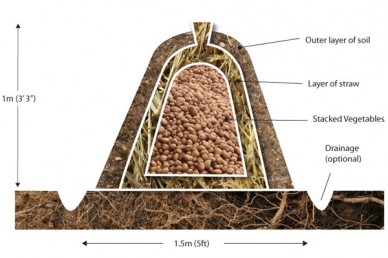How to: store root vegetables in a clamp

A clamp is a traditional device used to store an over abundance of root vegetables such as turnips, swedes, carrots and potatoes over winter. Simple to construct with minimal materials, it is the epitome of the gardener’s ingenuity and allows you to enjoy the fruits of your labour even when the ground is frozen solid.
Firstly select an area that doesn’t collect or retain water.
Place a layer of straw about 15-20cm (6-8 inches) deep over a circular area about 1.5m (5ft) wide.
Take the green tops off of your vegetables as they will rot in the clamp. Check for any damaged or rotten veg which should be discarded.
Create a stable mound of vegetables – largest at the bottom – and no more than a metre high.
Cover the entire mound with another 15-20cm of straw and then heap another 15cm of soil over this. Pat down with a spade to help rain run off.
It is important to construct a ‘chimney’ by leaving a clump of straw sticking out of the top. This allow excess heat from reactions inside the mound to escape maintaining the correct environment instead of just ruining your vegetables.
When you need to use vegetables from the mound open up the top or side and take what you need before sealing properly again afterwards.
Notes
Although it isn’t always necessary you may choose to dig a drainage ditch around the mound for extra protection from wet. The soil from the ditch can then be used to cover the mound.
You can initially add a layer of sand of about 20cm deep for the base of your mound if you think you may require more drainage.
If you have large amounts of spare veg either make additional clamps or increase the length, not the height, keeping it consistently 5ft wide to retain maximum efficiency.
Most recent Growing articles
- Five unusual and versatile vegetables to grow this spring 24th January, 2016
- Composting: what is it and why should you be doing it? 02nd November, 2015
- Know your onions: Growing onions, leeks, shallots and garlic 15th June, 2015
- Growers’ yearbook December – edible hedgerows and other ideas 01st December, 2014
- Growers’ yearbook November 04th November, 2014
- Growers’ Yearbook: October 04th October, 2014







Leave a reply